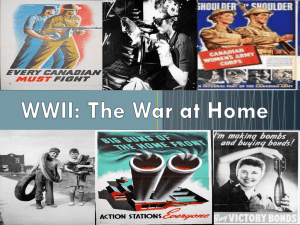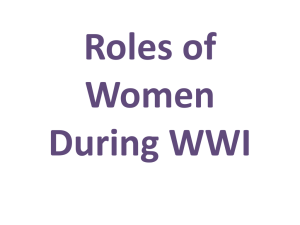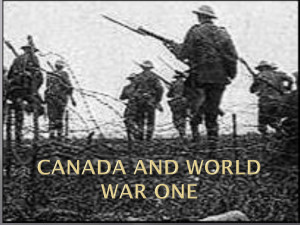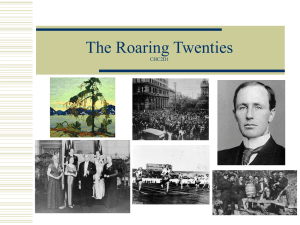Canada In WWII
advertisement
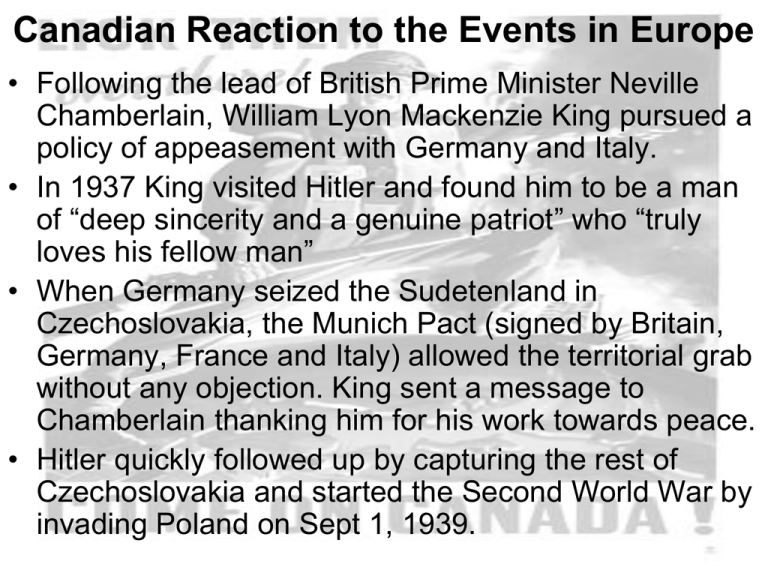
Canadian Reaction to the Events in Europe • Following the lead of British Prime Minister Neville Chamberlain, William Lyon Mackenzie King pursued a policy of appeasement with Germany and Italy. • In 1937 King visited Hitler and found him to be a man of “deep sincerity and a genuine patriot” who “truly loves his fellow man” • When Germany seized the Sudetenland in Czechoslovakia, the Munich Pact (signed by Britain, Germany, France and Italy) allowed the territorial grab without any objection. King sent a message to Chamberlain thanking him for his work towards peace. • Hitler quickly followed up by capturing the rest of Czechoslovakia and started the Second World War by invading Poland on Sept 1, 1939. Canadian Reaction to the Events in Europe • At the outbreak of the war, a small minority of Canadians called for neutralism and pacifism. The most notable figure being the CCF leader J.S. Woodsworth. • Canada went to war not because Hitler was a monster who had invaded Poland, not to fight for democracy, not to save the Jews of Europe but simply because Britain had gone to war. Britain had promised to defend Poland if Hitler invaded. • Because of the 1931 Statute of Westminster, Canada now had independent control of its foreign policy. • It is true that King waited week after Britain declared war before doing so himself, but this was mostly to prove that Canada could do so; there was never any doubt that Canada was Britain’s “banking ally”. Canadian Reaction to the Events in Europe • Few Canadians felt any excitement as the war began • Ten years of depression, unemployment, and hard times had sapped the national will, and there were too many who remembered the dead and maimed from the Great War • King pledged to not introduce conscription for overseas service. • Canada’s role would be one of “limited liability” during the war. This meant that Canada would contribute what it could and use the war to rebuild its economy. The Military Role of Canada • To mobilize the economy for war, King created the Department of Munitions and Supply in 1940 under the direction of industrialist C.D. Howe. • This department was the driving force behind Canada’s industrial contribution to the war. • At the outset of the war in 1939, King announced that Canadian forces would play three key roles: 1) an infantry division would be sent to Europe 2) the Royal Canadian Navy would shepherd convoys across the Atlantic 3) the Royal Canadian Air Force would run the British Commonwealth Air Training Plan(BCATP) • The BCATP took advantage of Canada’s wide-open spaces and relative safety. Aircrew trainees from all across the Commonwealth came to Canada to be turned into pilots, navigators, operators, and bombardiers. The Military Role of Canada • Many argue that the 132,000-strong aircrew produced by the BCATP was Canada’s greatest contribution to WWII. • As Germany quickly conquered virtually all of continental Europe by the summer of 1940, Canada’s plan for “limited liability” was jettisoned. • Recruiting was stepped up, war production was increased to supply the British demand, and units of infantry, artillery, RCAF squadrons were hurried across the ocean. • From 1939 until late 1941, Canada was Britain’s principal ally in the war effort. • Thousands of RCAF members were integrated into the Royal Air Force’s Bomber Command where they engaged in dangerous missions carrying the war into the heart of Germany every night. Canada’s Military Role • Early battles included a few serious losses. For example, 1975 Canadian infantrymen defending the British Crown Colony of Hong Kong were captured by the Japanese on Christmas Day, 1941. • Also, the attempt to land at Dieppe, France in August 1942 was a huge military blunder that resulted in 907 dead and 2000 captured. The only positive outcomes of the attack on Dieppe were that it prepared the Allied forces for the scale of assault needed to make D-Day successful and it convinced the USSR of the Allies’ commitment to the war. • By 1943, the Royal Canadian Navy was successful in chasing German U-boats from the sea and winning the Battle of the Atlantic. • Canadians, in participation with Americans and the British, launched a hard fought campaign in Sicily and Italy that saw Rome captured by June 1944. In these battles, soldiers fought room to room to overtake Italian and German soldiers. The battle of Ortona, Italy stands out amongst these fights. Canada’s Military Role • Also in June 1944, the Allied forces launched the invasion of Normandy, France called Operation Overlord (or more commonly D-Day). Canadian forces successfully landed at Juno beach and commenced their Eastward march across Europe. • Canadian soldiers battled through France and helped to free Holland. • The death toll for Canada’s participation in WWII included 22,917 in the army, 17,101 in the RCAF and 2204 in the Navy. (approximately 42,000) • By the end of the war Canada the third largest Navy and the fourth largest air force in the world. Inter-American Diplomacy • Both Canada and the USA were worried about their own national security by the summer of 1940 and decided to move towards greater cooperation. • Roosevelt and King were friendly and their governments had negotiated trade deals in 1935 and 1938, and there had even been tentative military staff talks in 1938. • In August 1940 King called FDR and suggested a meeting at Ogdensburg, New York. • There they established a Permanent Joint Board on Defence to plan for the defence of the continent and to coordinate the deployment of their forces. • The Ogdensburg Agreement was historic because it marked the shifting of Canada out of Britain’s sphere of influence and into that of the USA. Responses to the Ogdensburg Agreement were positive in North America but Winston Churchill was understandably critical. Inter-American Diplomacy • King again visited FDR in April of 1941 at the President’s home in Hyde Park, New York. • The resulting Hyde Park Declaration saw the USA agreeing to buy more raw materials and manufactured goods in Canada as well as allowing components to be imported into Canada under Lend-Lease. All of this allowed Canada to sidestep dollar deficits and more effectively supply the British war effort. • Thanks to the Hyde Park Declaration, Canada’s economic problems were quickly erased and the Canadian war economy boomed. • As a result, Canada was soon in a position to give away billions of dollars in munitions and foodstuffs. In total, Canada gave Britain $3.5 billion in aid. Inter-American Diplomacy • By the end of 1941, Canada started to be partly ignored by Washington, DC. The USA was now formally aligned with the other superpowers of Britain and the USSR in waging the war and had less time for a “middle power” • In an attempt to have more influence Canada applied the functional principle. For example, in diplomatic endeavours such as the Combined Food Board (which allocated scarce foodstuffs), Canada forced Britain and the USA to allow Canada a larger share of decision-making as a reflection of Canada’s role as a principal food exporter. • Canada was also active in cooperating with the USA on atomic and scientific research as well as in intelligence matters. Impact of the War on Labour • Increased demands for wheat, lumber, fish and minerals made unemployment disappear • Government and businesses desired peace on the labour front in order to maintain production • Ottawa passed regulations that recognized labour’s rights to bargain collectively and organize, to fair wages and a fair deal. The primary regulation was Privy Council Act 1003. PC 1003 was modelled on the US’s Wagner Act and became the basis for all subsequent labour law in Canada. • One preamble to PC 1003 states that, "the common wellbeing" is promoted "through the encouragement of free collective bargaining and the constructive settlement of disputes." • Union strength doubled from 359,000 in 1939 to 711,000 in 1945. Impact of the War on Business • While some business leaders were unhappy with the new rights of labour, overall business was good during the war. • There were products to be made in every factory and the cost-plus contracts with the government eliminated the usual risks for owners • The government aided the construction of plants, gave easy write-offs for costs and depreciation and, although taxes were high, profits were still good. • Unnecessary industries were squeezed out of the marketplace and forced to convert to war production. Eg. Fridges to Bren guns or tank tracks Impact of the War on the Economy • Living standards improved all across the country during the war. • The Gross National Product (GNP) rose from $5.6 billion in 1939 to $11.8 billion in 1945 and average wages, personal savings and government expenditures rose with it. • The cost of living remained static because of price controls and, in spite of high taxes, there was more money in Canada than there had been for years. • There were few things to buy due to military production so Canadians gave billions back to the government when they bought Victory Bonds. • It was a people’s war in Canada, fought by the people with equipment produced by the people and paid for by the people, and for once the people seemed to get some of the benefits. • • • • • • • Conscription King did not want to see a repeat of the Conscription Crisis that had damaged French-English relations during World War One. French and English Canadians needed to remain united, but this would be impossible if conscription was imposed on a reluctant Quebec by the Anglo-Canadian majority The National Resources Mobilization Act was passed in 1940 to create a conscripted force but for home defence only. This policy seemed favourable to most French Canadians, who had no quarrel with being expected to defend Canada. As the war deepened, King came up with the idea of a national plebiscite to free his government from its promise to not impose conscription. In early 1942, Quebec voted 72.9% against conscription while in Ontario (and most of English Canada) only 17.7% voted against forced military service overseas. King now found himself in a difficult position: should he listen to the majority will and impose conscription or favour national unity and not alienate Quebec? Conscription • The National Resources Mobilization Act was amended to make overseas conscription possible but only if it was deemed necessary. • King craftily claimed it was “not necessarily conscription, but conscription if necessary” • By 1944, there was a shortage of Canadian troops in Europe. Because Canada insisted on controlling its own forces in the war, a long supply line and reinforcement chain was necessary. Reinforcement shortages arose and wounded Canadians were being sent back out the front. • King decided that conscription had become “necessary” and sent 16,000 NRMA men overseas. In the end 2463 NRMA soldiers made it to the front and, of these, only 69 were killed. • The fallout in Quebec was sharply critical, but it did not destroy the Liberal government in Quebec. King still seemed the best of a bad lot of Anglo politicians to French Canadians. • By stalling until the end of the war, King had avoided a major division and the bloody riots that had accompanied the conscription crisis during WWI. Impact of the War on the Role of Government • The state began to intervene in every sphere of life, allocating resources, controlling production, and determining wages. • The Wartime Prices and Trade Board froze prices and wages in 1941 to avoid spiralling inflation. • Ration cards or tokens were issued for scarce items such as gasoline or meat • Housewives were encouraged to plant Victory Gardens to produce their own foodstuffs as well as to save fats and metals for the war effort. • The government mobilized for war in a way that made WWI efforts look amateurish. Impact of the War on the Role of Government • Canadians were afraid that depression conditions would return after the war; People wanted jobs, security and a good standard of living. • In response and under the influence of Keynesian economics, the federal bureaucracy became convinced that it needed to play a major role in directing the economy. • In 1940 a contributory scheme of unemployment insurance was created. • Further, in 1944 the family allowance or “baby bonus” began sending a monthly payment for each child. • These and other numerous programs created the modern welfare state or social welfare net that Canadians have come to expect. • The Liberal party stole these social welfare planks from Opposition parties (most notably the CCF) and established itself as the primary ruling party of Canada because it “delivered the goods”. • The government had changed with the war, and ideas of state intervention that in the 1930s had been denounced as unjustified interference with the laissez faire tradition were now heralded as essential Internment of Japanese-Canadians Internment of Japanese-Canadians • With the Japanese attack on Pearl Harbour on Dec. 7, 1941, the war had been brought close to North America and panic struck the West Coast. • Drawing on a long tradition of anti-Asian sentiment, politicians, newspapers and citizens’ groups called for action against the 23,000 JapaneseCanadians living in British Columbia • Most of these fisherpeople and market gardeners were Canadian citizens and the RCMP and military officials informed Ottawa that they posed no threat to Canadian security. Internment of Japanese-Canadians • Despite this, the Japanese-Canadians were rounded up, deprived of their livelihoods, and dispersed to internment camps in Canada’s interior. • Soon their property was sold at drastically undervalued prices and after the war the federal government attempted to deport as many Japanese-Canadians as possible back to Japan. • As the largest forced migration in Canadian history, this episode of systematic discrimination is widely believed to be one of Canada’s darkest moments. • In 1988 the Canadian government officially apologized for its treatment of Japanese Canadians. A symbolic redress payment of $21,000 was given to each survivor and an additional $36 million was put into cultural programming for the Japanese-Canadian community and anti-racism education more broadly. Impact of the War on Aboriginal Peoples • 3000 First NationCanadians served during WWII. This statistic does not account for any Inuit or Metis participants. • Because of the entrance restrictions used by the air force and navy, most Aboriginal people served in the army. • Aboriginal men joined to gain employment, to fight against nazism, and to carry on the tradition of their fathers and uncles who had served in WWI Impact of the War on •Aboriginal Peoples The war produced many decorated Aboriginal heroes. For example, Tommy Prince of Manitoba served as part of an exclusive battalion doing specialized reconnaissance and raiding missions. As the most decorated Canadian war hero, Prince was awarded the Military Medal by King George VI. • Despite their sacrifices, Aboriginal soldiers still faced discrimination and often returned to a Canada that relegated them and their families to the secondclass citizenship of reserve life. • It must be remembered that many First Nations soldiers were fighting for democracy abroad while they didn’t even have the right to vote in federal elections! Impact of the War on Women • Wives and older daughters stepped into industry to supply the necessary labour lost by men fighting overseas • By 1944, more than 1 million women were working full time and this figure does not include part-time women workers or the 800,000 women working on farms. • In 1943, 261,000 women were employed in war industries making artillery pieces, tanks, ammunition, ships and aircraft. In contrast to the sham of “Rosie the Riveter” in the USA, Canadian women did much of the same work as men in factories. • As a result, women earned substantially higher wages than were possible before the war. • Women also participated actively in the war effort. • Nearly 50,000 women enlisted in the Canadian Women’s Army Corps, the RCAF’s Women’s Division, and the Women’s Royal Canadian Naval Service. • A further 4,500 served as nursing sisters in the forces overseas. • The war did not emancipate women or win them full equality, but it did increase their opportunities by providing room for work outside the domestic sphere. Veronica Foster or “Ronnie” The Bren Gun Girl, John Inglis Co. in Toronto, ON Reaction to the Holocaust in Canada • In the 1930s German Jews fled Nazi Germany in order to escape persecution. • The Nuremberg Laws of 1935 had removed the rights of Jewish citizens and Kristallnacht in 1938 was a government-sponsored attack on the Jewish community. • Frederick Blair, King’s anti-Semitic minister of immigration, had effectively shut the doors to any Jews attempting to come to Canada. When asked how many Jews should be allowed to immigrate, Blair responded, “one is too many.” • Canada also turned away the steamship St. Louis that was filled with German Jewish refugees. When the ship returned to Germany, half of its passengers would perish during the Holocaust. Reaction To The Holocaust • As a result of Blair’s policies, Canada allowed fewer than 5000 Jews refuge in Canada during Hitler’s reign. This is in comparison to the USA (240,000) and Argentina (25,000). • Canada during WWII was still a very W.A.S.P. country and anti-Semitic views were still very common. • Though many people view Hitler’s systematic murdering of 6 million Jews and 5 million other “undesirables” (Gypsies, homosexuals, disabled people, Slavs and leftists) as a key feature of WWII, it was not a primary concern for Canadians during the war. Reaction to the Holocaust • By 1942, information detailing the slaughter of Jews became available to Allied leaders. • The Canadian Jewish Congress organized protests and did publicity to raise awareness of the issue and to allow refugees into Canada. • At the end of 1942, Canadian officials admitted that they knew 2 million Jews had been killed. Despite this, they argued that the solution was to defeat Germany militarily, not to admit refugees. Reaction to the Holocaust • Due to anti-Judaism within the general population, there was little support for accepting refugees or immigrants. • King was aware that pursuing a strong policy of refugee admission could possibly cause him to lose the next election. • When a petition was put forward by the Canadian National Committee on Refugees, nativist and anti-Judaic groups mobilized against it. • For example, the Canadian Legion’s paper wrote, “The future of Canada depends on the preservation of British institutions...there is no room in Canada for the cut throat competition of Japs or refugees” until all returned soldiers were re-integrated into Canada. Reaction to the Holocaust • At the end of the war there were 250,000 Jews left in Europe looking for homes. They were among the millions of DPs (Displaced Persons) still in camps. • In 1947 Canada allowed 8000 Jews into Canada under a few programs for orphans, first-degree relatives and needle trades/fur workers. • On the positive side, this reversed the decades-old trend of refusal and represented a higher percentage of Jewish immigrants (15%) than the total population of Canadian Jews as part of Canadian society(1.5%) • On the negative side, this total was pitiful compared with the demand. Also, it only came after the crisis of the Holocaust was over. Finally, and coincidentally, Canada only opened its doors at the time of the founding of Israel. Thus, many Jews decided to settle there instead. Canada and the Atomic Age • Canada had assisted the USA in its Manhattan Project of developing the atomic bomb. • A research and development facility to be used as part of the Manhattan Project was scheduled to be built in Montreal, but was cancelled when the bomb was developed earlier than planned. • Canada provided uranium from its western mines to be used in the atomic bombs. • After WWII ended the world quickly split between the capitalist west (USA, Britain, Canada, France, West Germany) and the communist east (USSR, and its satellites such as East Germany, Poland, etc.) • Although Canada never armed itself with atomic bombs, it did participate in the Cold War by joining the North Atlantic Treaty Organization (NATO).

